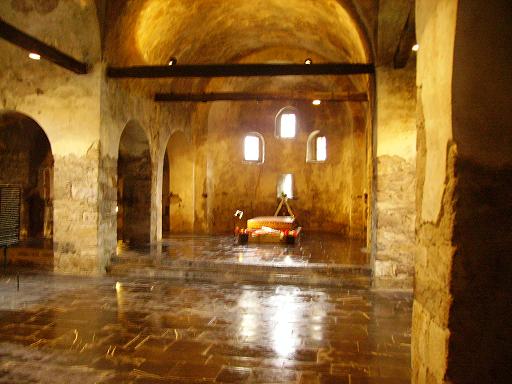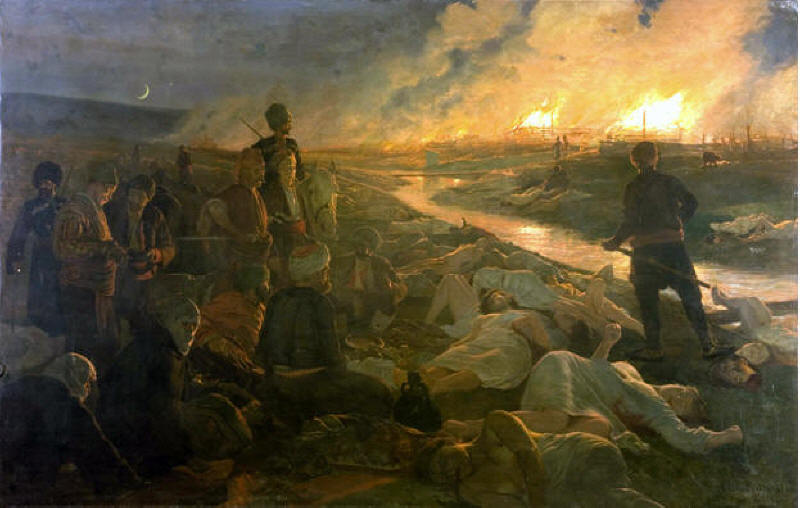 |
|
![]()
![]()
![]()
 |
The name of the small southern town of Batak will forever be associated with the April Uprising of 1876, one of the most heroic events in Bulgarian history, and a peak in the liberation struggle of the Bulgarians against the five centuries of Ottoman domination.
The residents of Batak first fought the Turkish mercenaries on April 30, 1876. 5 000 people of the 6-7 000 population of Batak had been slaughtered in the massacre. The small church of Sveta Nedelya, built in the centre of the town has become a relic for every Bulgarian. What happened here 130 years ago has made the church into one of the symbols of April Uprising. Says Ekaterina Peychinova, Director of the Museum of History in Batak:
"The Sveta Nedelya church was built in 1813, many years before the Christian population was granted greater freedoms to erect new Christian temples. Legend has it that Batak residents had finally got permission to build a small church. The Ottoman administration placed the condition that they do it in 3 months, because he was certain they would fail. However, the residents of Batak put all their efforts to this task and managed to finish the church in 75 days. And yet, the historical importance of this monument stems from the events that unfolded here during the April Uprising of 1876."
 |
|
|
The Church of Sveta Nedelya turned out to be the last stronghold of the rebels. Probably because it was built entirely of stone, and had strong oak gates, and a high stone fence, or because no one would have dreamt that the Turks would dare destroy the temple. Nearly 2 000 people, women, children and elderly people gathered inside the church. Says Ekaterina Peychinova:
"For three days and three nights the people inside the church held together, and the shooting outside did not stop for a minute. The attackers through beehives and set fire to straw, but the rebels would not give in. Then they began to suffocate and most of the people died of asphyxia. Thirst was the biggest problem for everyone, because there was no water near the church. The mothers used the oil from the icons to moisten the lips of their babies, and when there was no more oil, they used the blood of the dead. An elderly man said they should start digging the earth in search of underground water, but the spring of 1876 had turned a dry one and their attempts failed. At the end of the third day they caved in and opened the gates of the church. But then they had only two options: either become Muslims or die. Every single one of them chose death."
The Ottoman troops had made an attempt to burn the church down, but failed completely because the church had been built entirely out of stone. Only the wooden iconostasis perished in the fire. The Turkish authorities even tried to erase every trace of violence because of the news of the international inquiry committee that was due to carry out an investigation at the idea of the Russian government. They tried to bury the corpses in one mass grave, and even painted the church on the inside, but the blood came out, and the Turks started caving out the walls. These have remained as evidence of the events of the spring of 1876.
 Photos: courtesy of the Museum of History in Batak |
After the Liberation in 1878, the church was no longer used for religious purposes. The residents of Batak decided to keep it as a monument to the victims of the April Uprising
of 1876. In 1955 the church in Batak was declared a state museum and soon became one of the most frequently visited historical landmarks in Bulgaria. The local people like to say
that the small church that fails to impress with its architecture, and that ‘one has to bow to enter’ becomes ‘the great church of Bulgaria that one exits with one’s head high up."
Written by Miglena Ivanova
Translated by Radostin Zhelev
© Bulgarian National Radio
www.bnr.bg

Antoni Piotrowski: The massacre of Batak.
National Gallery for Foreign Art in Sofia, Bulgaria.
Виж също: